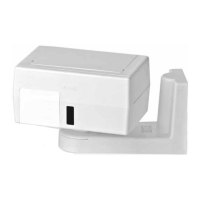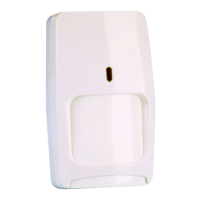- 1 -
Ceiling Mount Motion Sensor
INSTALLATION INSTRUCTIONS
Model DT-6360STC
RECESS
BUCKET
DT-6360STC
RETAINER
RING
If using the retainer ring, place it through, then directly over, the
hole in the ceiling tile. Make sure to orient the retainer ring
and recess bucket as shown in Figure 1.
Next, attach the back housing of the DT-6360STC to the inside
of the recess bucket, using the same screw holes and screws
used for surface mounting [#6 (M3.5) pan head]. Pull several
inches of wiring from the ceiling through the center hole in the
recess bucket and DT-6360STC back housing.
Insert the recess bucket into the hole in the ceiling, securing it to
the ceiling (and retainer bracket) with four mounting screws.
The DT-6360STC is shipped with a special kit for flush mount-
ing. The kit contains a recess "bucket" and retainer ring. The
retainer ring is only needed when flush mounting the unit in
ceiling tile. Removing the tile from the ceiling (if possible) will
make the installation process easier.
Flush Mounting
IMPORTANT: To ensure insects do not get inside the DT-
6360STC housing, make sure to seal all holes. (Recommended
sealant: silicone RTV.)
Note: If surface wiring, use the knockout hole on the side of the
housing.
If mounting the DT-6360STC directly on a ceiling, use the back
cover as a template to mark holes for the mounting screws and
wiring. Drill the holes. Then pull several inches of wiring from
the ceiling through the center hole in the back housing.
Attach the back housing to the ceiling with the mounting screws.
Recommended mounting screws: #6 (M3.5) pan head.
Surface Mounting
To remove the front cover, orient the DT-6360STC so that one of
the sides with the small rectangular slot in the center is visible.
Using a small flathead screwdriver, gently push down on the slot
while separating the housing parts. Set the front cover aside.
Remove the printed circuit board (PCB) by depressing one of
the retaining brackets at its sides. Use the microwave antenna
to carefully pull the PCB out.
MOUNTING PROCEDURE
Note: If you plan to use the DT-6360STC's tamper switches,
read the
Tamper Installation section on page 1.
CEILING
Figure 1
DT-6360STC
Flush Mounting Kit
The DUAL TEC
®
6360STC motion sensor provides maximum
coverage when mounted on ceilings from 8' (2.4 m) to 16' (4.8 m)
high. Refer to the
System Set-up section to determine which
passive infrared (PIR) mirror assembly to use at different ceiling
heights.
Choose a mounting location in the center of the protected area.
The protected area should be free of objects that might prevent
the PIR sensor from detecting an intruder: large pieces of
furniture, room dividers, etc.
Remember, infrared energy cannot penetrate solid objects. If the
PIR detector is blocked, the DT-6360STC will not trigger an alarm.
MOUNTING LOCATION
To flush mount the unit, cut a 5.5" x 5.5" (14 cm x 14 cm) hole in
the ceiling. Insert the recess bucket into the hole, using it as a
template to mark drill holes for the four mounting screws.
Remove the bucket and drill the screw holes.
The DT-6360STC is equipped with two tamper switches: a cover
tamper and ceiling tamper. When the tamper switches are used,
removing the cover from the sensor will activate the cover tamper;
removing the sensor from the ceiling will activate the ceiling
tamper. Both tamper switches are normally closed (NC) and
internally wired in series.
The cover tamper switch can be used without the ceiling tamper
and requires no modifications to the DT-6360STC housing.
To use the ceiling tamper, remove the square knockout in the rear
housing (directly behind the ceiling tamper switch), then install a
screw* in the ceiling. Leave enough of the screw protruding to
depress the tamper switch. Refer to Figure 2.
If the installation is recessed, remove the knockout from the rear
housing, drill a screw hole (behind the knockout) in the recess
bucket, then install the screw* in the recess bucket. Leave
enough of the screw protruding to depress the tamper switch.
Refer to Figure 2.
SURFACE MOUNT
FLUSH MOUNT
CEILING
DT-6360STC
Screw
to depress
tamper
Screw
to depress
tamper
DT-6360STC inside
recess bucket
CEILING
PIN FOR PCB
KEYHOLE
REAR HOUSING
KNOCKOUT
LATCH
Figure 2
Cover and Ceiling
Tamper Switches
*Note: #6 (M3.5)
pan head is
recommended.
Tamper Installation












